
|
|
Artifacts
 
The Harvey Bottles and Jars
The most important and relevant artifacts in the museum are unquestionably those bottles and jars first imported from Britain about 1830 by James Harvey, the second pharmacist-owner. As mentioned in an earlier description of the Niagara Apothecary’s interior, they cover the shelves from top to bottom along the whole wall to the right as you enter the shop and to a much lesser extent across the back. (We see here the drug bottles and jars lining the shelves along the wall as one enters the Apothecary.)
At the very top are the large green carboys with clear glass ground-glass stoppers that held stock liquids in large quantity, such as oils, tinctures (usually alcohol based fluids), wines (that is wine based medicinal preparations, acids, etc.). Because they were hand blown glass, their appearance was not uniform from one to the other, unlike the other containers below. |  |
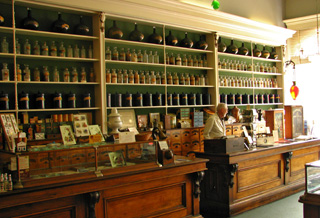
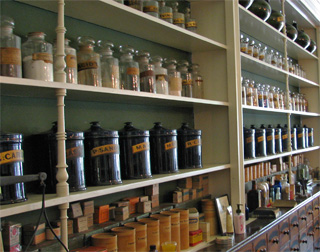 |
The next row down holds large glazed cobalt blue jars with matching tops for powdered substances or unrefined crude drugs or ointments or pills. The next two rows respectively hold clear glass tincture bottles (with narrow necks) to hold liquids, corresponding to contents of the green carboys, and “salt mouths” (with wide necks) to hold powders, etc, corresponding to contents of the cobalt blue jars. The latter containers would be those usually removed and taken to the dispensary unit for compounding prescriptions.
All these containers, as also noted previously, have matched gilt labels in Latin. The labels also match those on the bins and drawers below the shelves that hold drugs in their crudest. (We see here an assortment of the containers described above, as well as the coordinated drawers and bins.)
All these containers also served a secondary purpose, to test the apprentices on their knowledge of Latin, as well as the medicinal uses and preparation of the substances contained therein. (We see Apothecary staff here playing the role of the pharmacist and young apprentice demonstrating the learning process.)
|
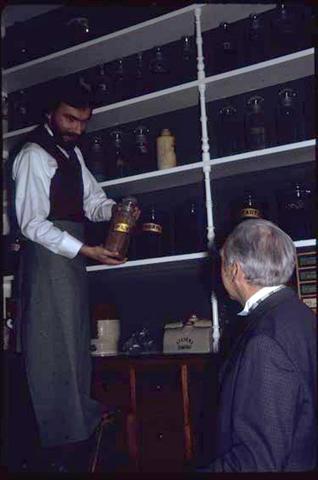
|  | 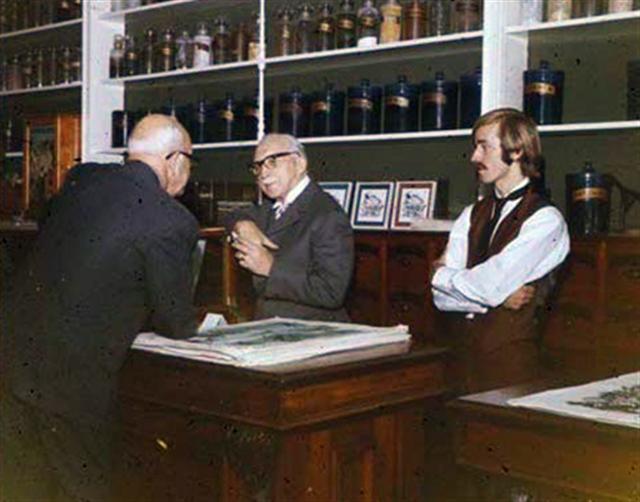 |
Mortars and Pestles
Perhaps no tool of pharmacy has become more symbolic of the profession than the mortar and pestle, although in recent times perhaps more popular in the Anglo-American countries, especially Canada and the USA. They are less popular in many European countries because of their association sometimes with non-pharmacist shopkeepers.
Mortars and pestles trace back to prehistoric times and civilizations because of their use in the preparation of certain kinds of food.
Over the centuries, it has been made from many materials and in varying sizes as those in the Apothecary testify. Glass and plain Wedgwood now predominate, but iron, brass, pewter, wood, china, etc. have served at various times in the past. |  |
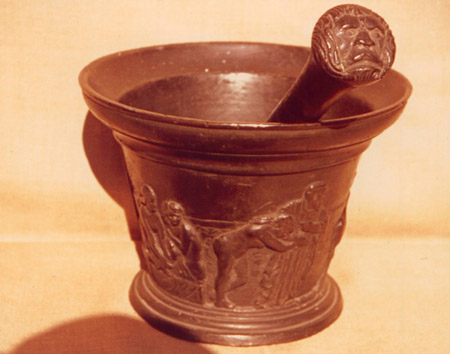
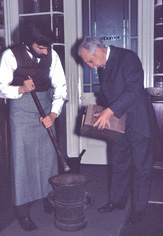 |
Two in the Apothecary are of particular interest. The one seen here from the Williams Collection in the Apothecary is identified as being made of English bell metal (an alloy of copper and tin) or church bells melted down during Henry VIII’s destruction of Roman Catholic churches and monasteries in the 16th century. Shown in the second photo is the largest mortar and pestle at the Apothecary, a contusion-type made of cast iron usually used to break down some large pieces of crude drugs or chemicals to a manageable degree. Here we see the pharmacist attendant supervising the apprentice attendant in a learning situation. In some cases, the pestle may have been suspended from above to make for easier handling and greater degrees of contusion. In other cases, it might be operated by two people working together holding one pestle between them to achieve harder striking power. Particularly smelly or dusty procedures might also be carried on outdoors.
|
The Leech Jar
This 19th century white glazed china leech container is the hands-down favourite among the Niagara Apothecary artifacts. It is about 0.5 m (20 inches) tall with a perforated lid to assure a suitable degree of ventilation for the leeches. Leeches were sold to facilitate blood letting therapies now largely outmoded. |  |
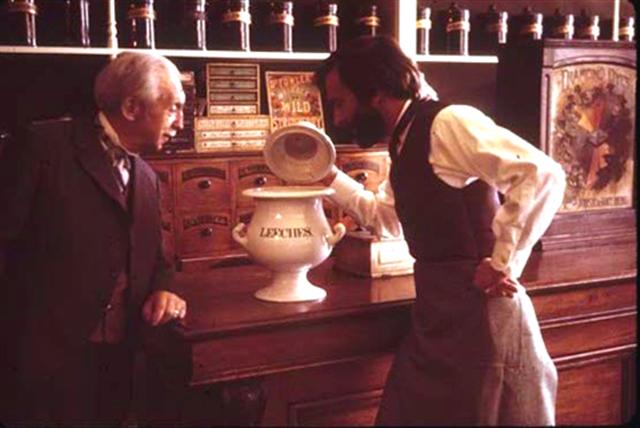 |
They were formerly used for a variety of conditions from headaches to black eyes and applied to just about every part of the body. Although their use never disappeared in some cultures, today, leeches are used to re-establish blood circulation in plastic and restorative surgery, taking advantage of the anticoagulant that leeches secrete, called hirudin. Leeches also facilitate their blood meal by dilating the host's vessels thus also aiding in restoring blood circulation.
Leeches were so popular early in the 19th century in countries like Britain and France, that millions of leeches were imported to keep up with the demand. Leeches were long collected by men or women or some animals, like old-spent horses, wading in waters they were known to inhabit, since they would tend to collect on exposed parts of the body and would then be removed and sold. (We see here the attendant apprentice and pharmacist checking on the health of their charges in the leech jar)
Displayed near the leech jar are some other health related items of interest from the medical practices and pharmacies of yesteryear are such as items as plaster medication, scarifiers for facilitating bloodletting, and enema equipment.
|
Miscellaneous Tools of the Apothecary
While the mortar and pestle is probably the utensil most identified with pharmacy, there were many others in earlier times reflecting the degree of in-house preparation common before the large-scale manufacturers of today. These other tools also reflect some dosage forms or preparations that have become obsolete or at least obsolescent. Indeed a survey in the last quarter of the 20th century found that probably the most used utensil by the pharmacist had become the stirring rod! On the other hand, in more recent times there has been a major revival of the art of compounding. The 19th and first half of the 20th century saw pill machines, cachet machines, suppository machines, plaster spreaders, powder-paper folders, etc. Moreover, the design of many in the 19th century show a decided Victorian influence in the degree to which decorations might be applied to the commonest tools, like cork presses, to make corks more malleable and easier to get into bottles (before screw caps). A variety of these tools or utensils may be on display at a particular time either as part of special exhibits or simply in place as they would have been in an operating pharmacy of the period.
|
Patent or Non-Prescription Remedies
Along the glass enclosed upper shelves lining the northwest side of the Apothecary (seen at right), visitors will find hundreds of examples of proprietary or non-prescription remedies which were sold in pharmacies in the late 19th and early 20th centuries, along with some of their wide-ranging curative claims. Prior to 1908 in Canada and 1906 in USA, no regulation as to efficacy claims existed.
|  |
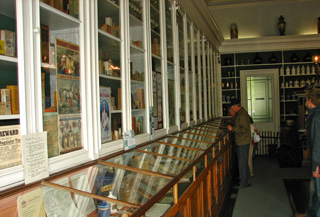 |
19th-Century Inhalers
Inhalers have taken various forms through time, but perhaps most decorative are some of the 19th-century English ones. (Two examples of these inhalers are on display at the Apothecary) A blue on white, English Delft design was common, like the Maw’s one; while the brown on white Milton one was seen less frequently. Both were part of the extensive donation of a large variety of interesting items by Kitchener-Waterloo pharmacist Fred Blayney, now retired. |
 |
Show Globes and Containers
The Niagara Apothecary boasts a large variety of different styles of so-called show globes or show containers. Some are plain glass; others, cut-glass. Some may be multi-tiered. (Like these samples at left.) Others are pendant or hanging. (Like this example) Still others may be in specific shapes, such as mortars and pestles. (We see a great variety of styles and colours here.)
Show globes had their origin about the time of the great plague in London, when apothecaries would keep glass carboys with colored liquids in their windows to show the ill where to come for professional help, particularly since many professionals had fled the city since there was no sure treatment for the plague. Because of their origin, show globes became popular mainly in Anglo-American countries, like Canada and the USA with their British origins. |  |
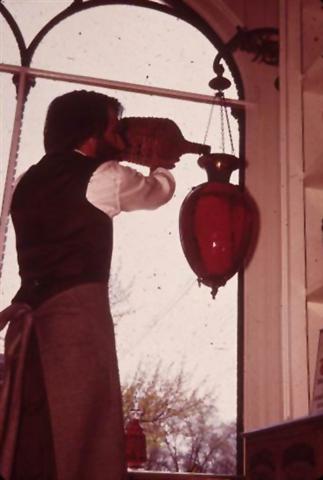
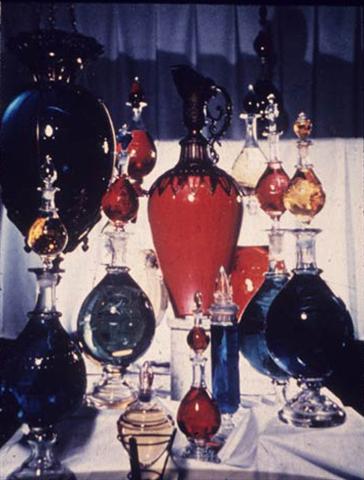
|
They reached their most diverse forms in the 19th and early 20th centuries. They were filled primarily with colored water or sometimes with layers of oil and water to incorporate different colors. They were usually lighted from behind at night to serve as beacons for those seeking help. Traditionally, pairs on either side of shop windows used green and red. As mentioned in the section about the elaborate dispensary in the Apothecary, the lighted globes held aloft on either side at the top were thought from some surviving evidence and period photos to originally have had glass globes colored red and green. Show globes have sometimes been termed, "the barber pole of pharmacy." Today the colouring is made easy by the use of aniline dyes or even food colours. Complex formulas containing iron, copper or chromium salts were needed in the 19th century to produce the desired colours.
|
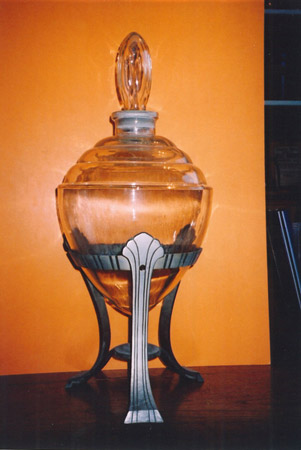 |  | 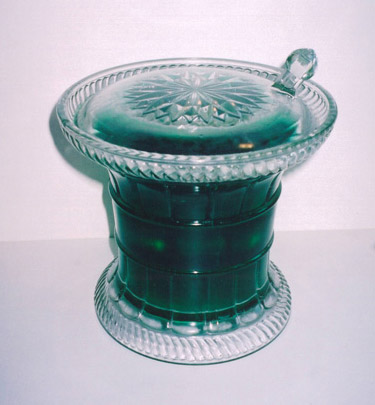 |
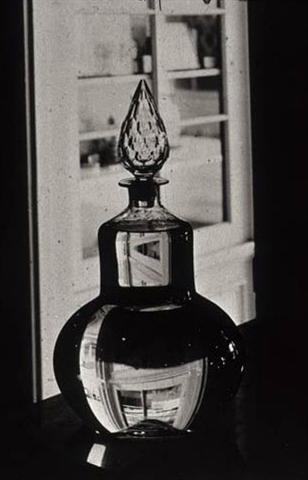 |  | 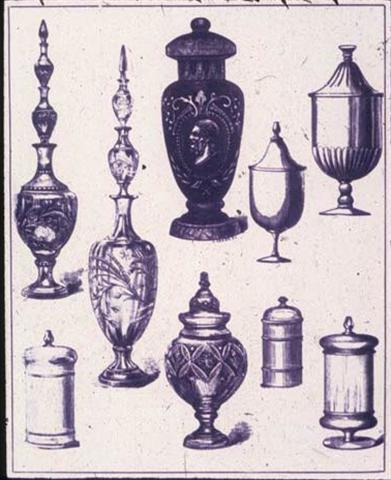 |
 |
The Ophthalmic Test Card
The ophthalmic test card shown here was one of several cards contained within the ornate box to check the sight of patrons of British and canadian pharmacies in the late 19th and early 20th century. The practice was considered a legitimate auxiliary professional activity for pharmacists to accompany their primary pharmaceutical practices. |  |
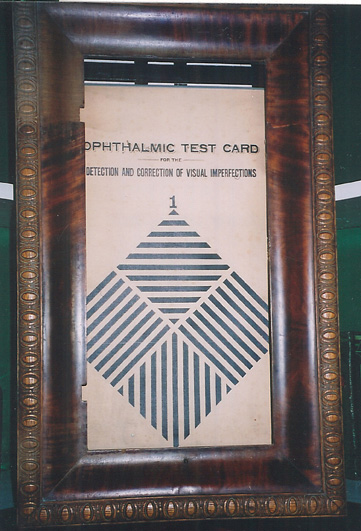
|
|  |
Stevens Comfort
This ceramic “Stevens Comfort” container was commonly used in the 19th and early 20th century as a from of hot water bottle - using either water or hot coals - particularly to warm beds and body before central heating became common. |
The Enema Box
Enemas were a popular form of treating a variety of conditions from ancient times onward. By the Victorian era the equipment sometimes reflected the overly prudish ways of, then contemporary, society. Thus this enema apparatus when closed within its mahogany and brass box, could sit in full sight without necessarily showing the personal application of the equipment. The user basically sat and impaled him/herself on the ivory projection and pushed down on the plunger at the front to force the necessary fluid up. |  |
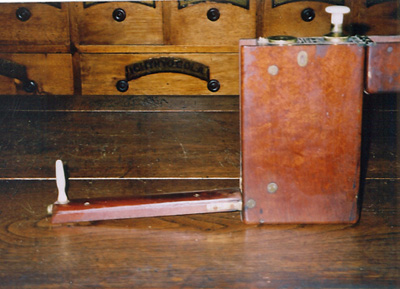
|
|  |
The Scales
The scales shown here remained in active use until Erland Field closed the practice in 1964, as indicated by the official red government seal between the two brass weights. Such scales were normally used to weigh larger quantities than would have been needed for more precise weighing for prescriptions, done with fine professional balances. |
Early Cash Register
John de Witt Randall, the fourth pharmacist-owner (1898-1914), installed a new-fangled oak cash register manufactured by National Cash Register of Dayton Ohio in 1903 (on display at the Apothecary). A sale was recorded by writing the amount on the exposed paper with a steel pen using the ink from its inkwell. When the cash drawer opened, a bell rang and the recording paper ratcheted up one notch. Customers did not get a receipt but one may assume that they did get a "Thank You!"
|  |
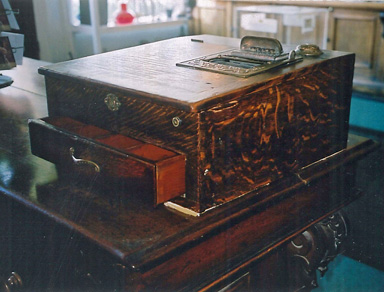
|
 |  |  |
Perfume Dispenser
The Perfume Dispenser dates from 1892. The customer inserted a large as a quarter in those days one cent coin into the slot, sharply pulled the lever and a spray of “the finest Paris” perfume came through a large flower as a bell tinkled into the recipient's hand or on to her handkerchief. The claim, "a scent for a cent," was visibly displayed on its front. Lemp Pharmacy in Tavistock Ontario donated this fascinating example of impulse merchandising shortly after the museum's opening.
|  |
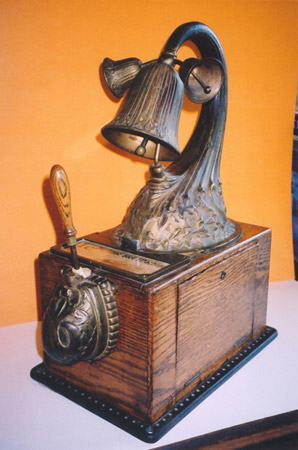 |
The Frosst Dingbat Calendars
From 1915 until 1996, health professionals all across Canada received a calendar which featured the healing efforts of the Dingbats. Charles Edward Frosst founded the Canadian company that bore his name until 1965 when it was taken over by a major American manufacturer to become Merck-Frosst. Charles Frosst engaged the artist, William Dudley Burnett Ward, to paint an appealing calendar for distribution to his firm's audience.
It was so appealing the Frosst continued the resulting Dingbat� calendars for 81 years with a succession of different artists.
However, the Dingbat calendars were discontinued as a result of a Canadian industry's association decision that the Dingbat promotion was unfair competition. |  |
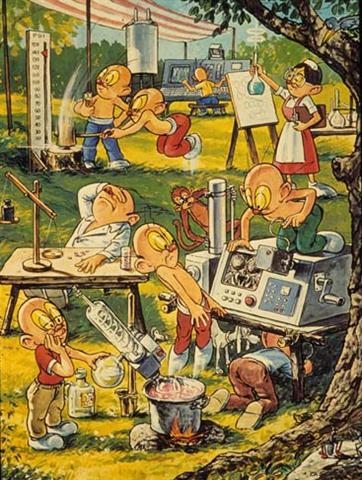 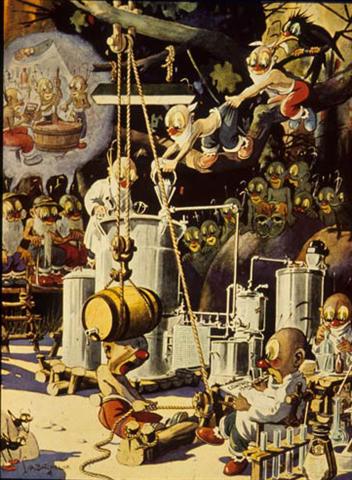
|
This decision was a monumental error in the widespread view, even among competitors, as the Dingbats were seen by many as an ornament benefiting the entire industry. (We see here, from 1949, “50 Years of Progress in Dingbatland”; and another, from 1986, “Pharmaceutical Research in Dingbatland.”
Miscellany
The variety of articles sold in the Apothecary over its long history certainly changed immensely over time. Among those still preserved in the museum and displayed primarily along the wall that houses the proprietary remedies are: toiletries, infant feeding bottles and nipples (seen below), nipple shields, razors. Elsewhere, there are chests of dyes for clothing and straw hats. A device intended to cut the tip from the gentlemen patron’s cigars sits nearby infant scales.
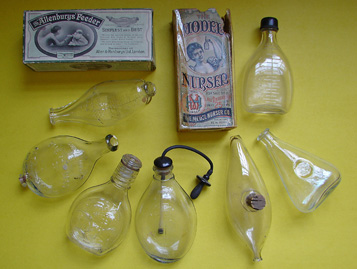
|
|
Special Exhibits
Without going into details, the following are among current exhibits on display in the museum:
� Pill making
� Patent or proprietary remedies and their advertising
� The Niagara Apothecary Practice and its Pharmacists
� Prescriptions
� Remedies of North-American First Nations
� Pharmacy’s Symbols, International and Canadian
The Williams Collection is on long term loan from the Ontario College of Pharmacists, contains some remarkable artifacts from various times over many centuries and places collected by a Sarnia, Ontario pharmacist.
Addendum
The present account on this website concerning the pharmacist owners, their practices and pharmacies ends with Henry Paffard, whose personal concerns for what is now Niagara-on-the-Lake led not only to major contributions to the town, many of which remain, but also to opening in 1869 the magnificent building that survives today restored as the Niagara Apothecary Museum. The story does continue beyond Paffard with three successor pharmacist-owners: John DeW. Randall from 1898 to 1914; A. J. Coyne, 1914 to 1922; and Erland W. Field, 1922 to 1964, when it closed as an active practice. The intention is to add their stories to this website in due time. However, one of those individuals, A. J. Coyne, played a major personal role in making the restoration of the professional practice aspects of the Apothecary as genuine and relevant as they are. Consequently, that significant information does form part of our description of the interior of the Apothecary as Paffard conceived and executed it, and as visitors see it today.
Finally, additional photographic images when those exist will also be added from time to time throughout the text on the website.
 
|
|
 |


